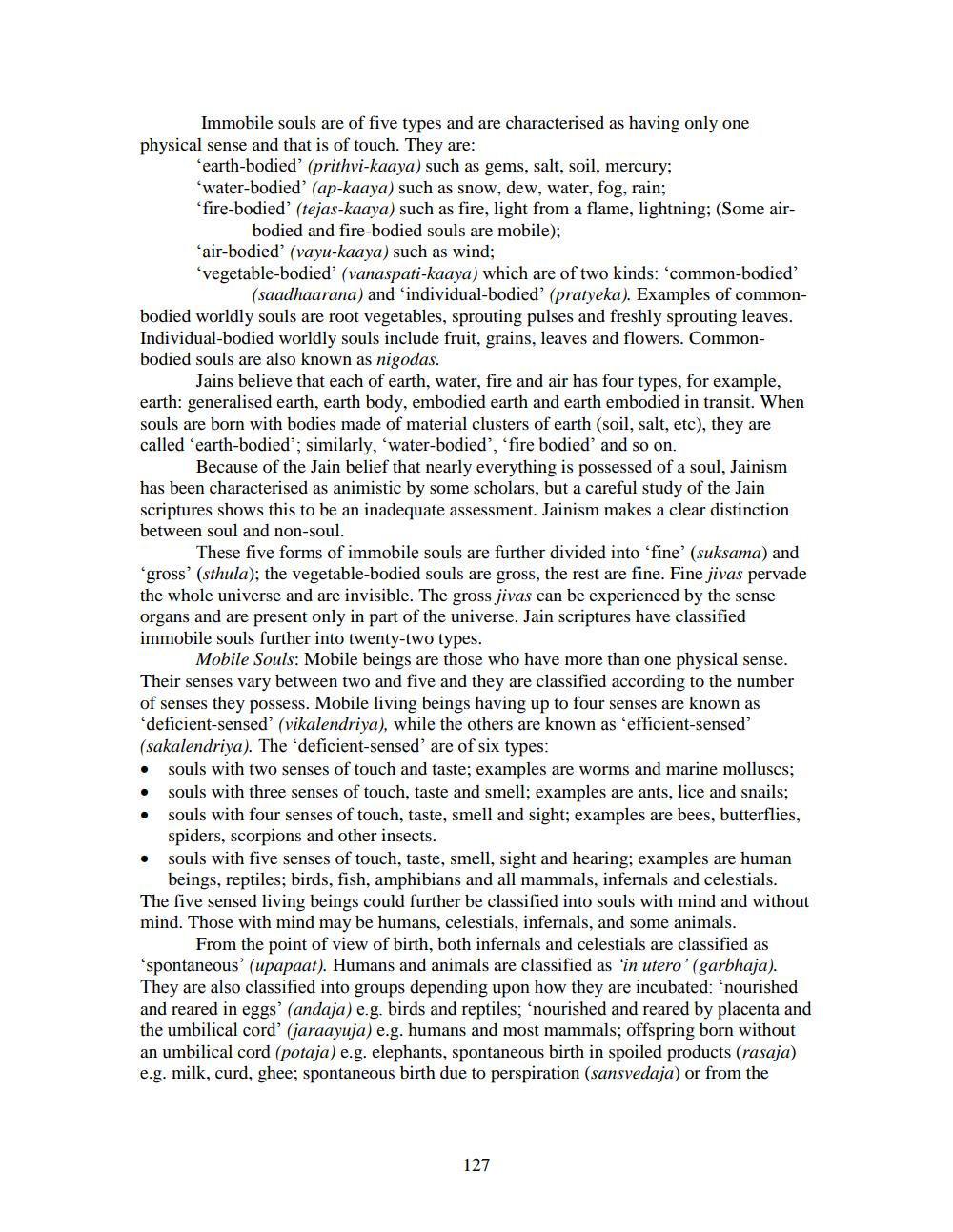________________
Immobile souls are of five types and are characterised as having only one physical sense and that is of touch. They are:
earth-bodied' (prithvi-kaaya) such as gems, salt, soil, mercury; ‘water-bodied' (ap-kaaya) such as snow, dew, water, fog, rain; 'fire-bodied' (tejas-kaaya) such as fire, light from a flame, lightning; (Some air
bodied and fire-bodied souls are mobile); air-bodied' (vayu-kaaya) such as wind; vegetable-bodied' (vanaspati-kaaya) which are of two kinds: 'common-bodied'
(saadhaarana) and individual-bodied' (pratyeka). Examples of commonbodied worldly souls are root vegetables, sprouting pulses and freshly sprouting leaves. Individual-bodied worldly souls include fruit, grains, leaves and flowers. Commonbodied souls are also known as nigodas.
Jains believe that each of earth, water, fire and air has four types, for example, earth: generalised earth, earth body, embodied earth and earth embodied in transit. When souls are born with bodies made of material clusters of earth (soil, salt, etc), they are called 'earth-bodied'; similarly, 'water-bodied', 'fire bodied' and so on.
Because of the Jain belief that nearly everything is possessed of a soul, Jainism has been characterised as animistic by some scholars, but a careful study of the Jain scriptures shows this to be an inadequate assessment. Jainism makes a clear distinction between soul and non-soul.
These five forms of immobile souls are further divided into 'fine' (suksama) and gross' (sthula); the vegetable-bodied souls are gross, the rest are fine. Fine jivas pervade the whole universe and are invisible. The gross jivas can be experienced by the sense organs and are present only in part of the universe. Jain scriptures have classified immobile souls further into twenty-two types.
Mobile Souls: Mobile beings are those who have more than one physical sense. Their senses vary between two and five and they are classified according to the number of senses they possess. Mobile living beings having up to four senses are known as
deficient-sensed' (vikalendriya), while the others are known as 'efficient-sensed' (sakalendriya). The deficient-sensed' are of six types:
souls with two senses of touch and taste; examples are worms and marine molluscs; souls with three senses of touch, taste and smell; examples are ants, lice and snails; souls with four senses of touch, taste, smell and sight; examples are bees, butterflies,
spiders, scorpions and other insects. • souls with five senses of touch, taste, smell, sight and hearing; examples are human
beings, reptiles; birds, fish, amphibians and all mammals, infernals and celestials. The five sensed living beings could further be classified into souls with mind and without mind. Those with mind may be humans, celestials, infernals, and some animals.
From the point of view of birth, both infernals and celestials are classified as 'spontaneous' (upapaat). Humans and animals are classified as 'in utero' (garbhaja). They are also classified into groups depending upon how they are incubated: 'nourished and reared in eggs' (andaja) e.g. birds and reptiles; 'nourished and reared by placenta and the umbilical cord' (jaraayuja) e.g. humans and most mammals; offspring born without an umbilical cord (potaja) e.g. elephants, spontaneous birth in spoiled products (rasaja) e.g. milk, curd, ghee; spontaneous birth due to perspiration (sansvedaja) or from the
127




